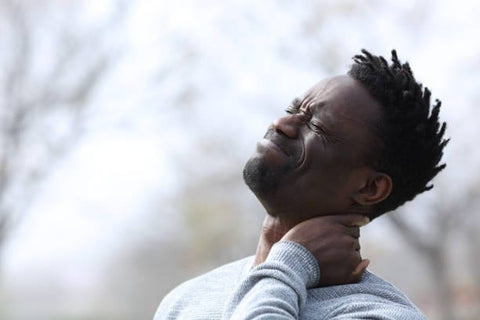ARTHRITIS

The term arthritis (from the Greek arthron: joint, and from the Latin ite: inflammation) refers to more than a hundred different conditions characterized by pain in the joints, ligaments, tendons, bones or other elements. of the musculoskeletal system.
In the past, the word rheumatism (from the Latin rheumatismus, for "flow of moods") was used instead to designate all these conditions. This term is now considered obsolete.
Remark. Some forms of arthritis are characterized by the presence of inflammation, but not all. Inflammation is the body's natural reaction to irritated or infected tissue. It causes swelling, pain and redness to the affected area of the body.
Causes
Most often, arthritis is inflammation linked to an autoimmune disease, genetic and environmental factors that are still poorly understood. It is then a chronic disease.
In some cases, arthritis can also occur after infection with bacteria or viruses. In this case, there is often only one affected joint.
When caused by the overgrowth of microbes in the joint, arthritis is called "septic arthritis."
Number of joints affected
Depending on the type of arthritis, the number and location of affected joints vary a lot:
an affected joint: we speak of monoarthritis;
two to 3 affected joints: we speak of oligoarthritis;
many affected joints: this is called polyarthritis.
The number of affected joints is an indicator that helps the doctor make the diagnosis.
The different types of arthritis
The two main forms:
Osteoarthritis is the most common arthritis; it is said to be formed "with wear". It's degenerative arthritis. The destruction by wear and tear of the cartilage that covers and protects the bones of the joint and the appearance of small bony growths characterize this disease. It mainly affects the joints that support a large part of the body weight, such as the hips, knees, feet and spine. Osteoarthritis is often age-related, or caused by excess weight or the repeated use of a joint while playing sports. It rarely appears before 40.
Rheumatoid arthritis is an inflammatory disease. The joints of the hands, wrists and feet are often the first to be affected. Other organs can be affected as the inflammation affects the whole body. This type of arthritis usually starts around 40 to 60 years old, but it can start in early adulthood. Rheumatoid arthritis is 2-3 times more common in women than in men. Although scientists have yet to find out its cause, it appears to be autoimmune in origin and influenced by heredity. Other, most common forms of arthritis:
Infectious arthritis. It can occur when an infection directly affects a joint and causes inflammation;
Reactive arthritis. This form of arthritis also appears as a result of infection. But in this case, the infection is not located directly in the joint;
Juvenile arthritis. A rare form of rheumatoid arthritis which occurs in children and adolescents, and which often gets better with age;
Psoriatic arthritis. A form of arthritis that is accompanied by skin lesions typical of psoriasis;
Gout and pseudogout: The deposit of crystals in the joints, in the form of uric acid in the case of gout or as calcium phosphate in the case of a pseudogout, causes inflammation and pain, often in the big toe in the first place.
Lupus. It is considered a form of arthritis since it is one of the chronic autoimmune diseases. It is a connective tissue disease that can cause, in its most common and serious form, inflammation of the skin, muscles, joints, heart, lungs, kidneys, blood vessels and of the nervous system.
Scleroderma. A chronic autoimmune disease characterized by hardening of the skin and connective tissue damage. It can affect the joints and cause the typical symptoms of inflammatory-type arthritis. Systemic scleroderma can affect internal organs, such as the heart, lungs, kidneys, and digestive system.
Ankylosing spondylitis. A chronic inflammation of the joints of the vertebrae of the back that develops gradually and causes stiffness and pain in the back, torso and hips.
Gougerot-Sjögren syndrome. A serious autoimmune disease that initially affects the glands and mucous membranes of the eyes and mouth, causing these organs to dry up due to decreased production of tears and saliva. In its primary form, it affects only these glands. In its secondary form, it can be associated with other autoimmune diseases, such as rheumatoid arthritis and lupus.
Polymyositis. A rare disease that causes inflammation in the muscles, which then lose their strength.In all inflammatory arthritis, connective tissue is affected by the inflammation. Connective tissues serve as support and protection for organs. They are found in the skin, arteries, tendons, around organs or at the junction between two different tissues. For example, the synovial membrane, which lines the cavities of the joints, is connective tissue.
Other diseases are linked to different forms of arthritis and sometimes form in association with them, such as plantar fasciitis, fibromyalgia, Lyme disease, Paget's disease of bone, Raynaud's disease and duct syndrome. carpal tunnel Most arthritic diseases are chronic. Some will lead to the deterioration of joint structures. This is because stiffness decreases the mobility of the joint and the muscles around it atrophy, which accelerates the progression of the disease. Over time, the cartilage crumbles, the bone wears down, and the joint can become deformed.
Symptoms
Different forms of arthritis have their own symptoms and course, which vary widely from person to person. For example, osteoarthritis most often manifests as pain and stiffness in a single joint. Rheumatoid arthritis is often accompanied by swelling and redness in several joints. However, joint and musculoskeletal pain is common to all types of arthritis.
Diagnostic
Diagnosis is mainly based on questioning and clinical examination (inspection of the joints, checking the range of motion), medical imaging (standard x-rays and in some cases on an ultrasound, a CT scan or an MRI). These examinations make it possible to visualize and assess the degree of joint damage (calcifications). If there is an effusion, an examination of the synovial fluid is performed.
Prevention
Rest, relaxation and sleep
The first weapon against arthritis pain would be rest, especially for people in whom stress, anxiety and nervous fatigue are very present. Breathing exercises, mental relaxation techniques, and meditation are all ways to help the body achieve relaxation.
Exercise
People with arthritis need to exercise in order to maintain joint mobility and maintain muscle mass. Exercise also has an analgesic effect since it causes the release of endorphins in the body. However, it is important to aim for a balance between periods of rest and activity, by "listening" to your body. Fatigue and pain are good indicators. When they do occur, it is better to take the time to relax. On the other hand, too much rest can cause stiffness in the joints and muscles. The objective to be achieved is therefore a certain balance between periods of activity and relaxation, which will be specific to each person.
Several exercises are possible, we must choose the ones that suit us, going gradually. It is better to use the services of a physiotherapist (kinesiologist) or occupational therapist in situations where certain tasks are difficult to accomplish. The movements should be regular, flexible and slow. Performed in hot water, the exercises put less stress on the joints. See also the Tastes and Needs Game in the Physical Fitness sheet.
It is suggested to combine different types of exercises to get the benefits of each.
Stretching helps maintain motor skills and flexibility in muscles and tendons, while reducing stiffness in the joints. They should be practiced gently and maintained for 20 to 30 seconds;
Amplitude exercises aim to maintain the normal capacity of the joint by making it move in full amplitude. They prepare the joint for endurance and strength training exercises;
Endurance exercise (such as swimming and cycling) improves cardiovascular condition and overall physical fitness, increases well-being and helps in weight control;
Strength exercises are used to maintain or develop the musculature, necessary to support the affected joints.
Massage therapy
Massages relax the muscles and relax the entire body, relieving pain and cramps. It is important to talk to the massage therapist about your condition so that he can adapt his practice accordingly. You can also combine massage with thermotherapy, for example by taking a hot water bath in a jetted tub.
Healthy weight
People who are overweight and suffer from arthritis would benefit from losing the extra pounds. Even modest weight loss is beneficial in reducing pain. This measure becomes particularly important in cases of osteoarthritis, since being overweight is a major risk factor, but also for other forms of arthritis.
Natural solution with Artimède
Arthritis can be effectively and naturally treated with Artimedes. Artimède is a natural component balm that brings relief and healing. It removes joint pain and swelling, stops joint damage and restores bone and muscle structure and structure.
Now also available in capsule
